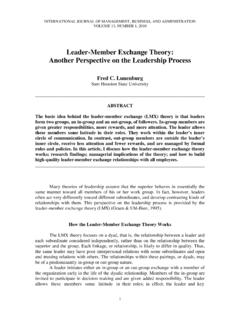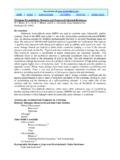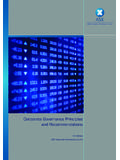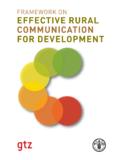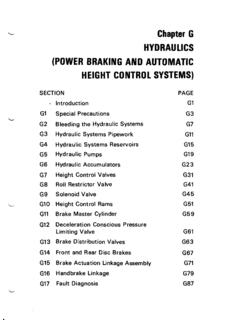Transcription of Linkage & Genetic Mapping in Eukaryotes
1 11 Linkage & Genetic Mapping inLinkage & Genetic Mapping inEukaryotesEukaryotesCh. 6Ch. 622!!In eukaryotic species, each linearIn eukaryotic species, each linearchromosome contains a long piece of DNAchromosome contains a long piece of DNA A typical chromosome contains many hundredA typical chromosome contains many hundredor even a few thousand different genesor even a few thousand different genes!!The term Linkage has two related meaningsThe term Linkage has two related meanings 1. Two or more genes can be located on the1. Two or more genes can be located on thesame chromosomesame chromosome 2.
2 Genes that are close together tend to be2. Genes that are close together tend to betransmitted as a unittransmitted as a unitCopyright The McGraw-Hill Companies, Inc. Permission required for reproduction or displayLINKAGE AND CROSSING OVERLINKAGE AND CROSSING OVER33!!Chromosomes are called Chromosomes are called Linkage groupslinkage groups They contain a group of genes that are linked togetherThey contain a group of genes that are linked together!!The number of Linkage groups is the number ofThe number of Linkage groups is the number oftypes of chromosomes of the speciestypes of chromosomes of the species For example, in humansFor example, in humans""22 autosomal Linkage groups22 autosomal Linkage groups""An X chromosome Linkage groupAn X chromosome Linkage group""A Y chromosome Linkage groupA Y chromosome Linkage group!
3 !Genes that are far apart on the same chromosomeGenes that are far apart on the same chromosomecan can independently assortindependently assort from each other from each other This is due to This is due to crossing-over or recombinationcrossing-over or recombinationCopyright The McGraw-Hill Companies, Inc. Permission required for reproduction or displayLinkage GroupsLinkage Groups44 Linkage and Linkage and RecombinationRecombinationGenes nearby on the same chromosome tend to stay togetherGenes nearby on the same chromosome tend to stay togetherduring the formation of gametes; this is during the formation of gametes.
4 This is breakage of the chromosome, the separation of theThe breakage of the chromosome, the separation of thegenes, and the exchange of genes between genes, and the exchange of genes between chromatids chromatids isisknown as known as recombinationrecombination. (we call it crossing over). (we call it crossing over)55 Independent assortment:Independent assortment:Genes on different chromosomesGenes on different chromosomesAAaaBBbbaBABabAbGametes66 AAaaBBbbGametesabABABabLinkage: Linkage : Two genes on same Two genes on samechromosome segregatechromosome segregatetogethertogether77 Linkage and Crossing over leads toLinkage and Crossing over leads toseparation of linked genesseparation of linked genesAAaaBBbbGametesaBABA babxParental Recombinant88 Crossing Over Can Produce RecombinantCrossing Over Can Produce RecombinantPhenotypesPhenotypes!
5 !In diploid eukaryotic speciesIn diploid eukaryotic species Linkage can be altered during meiosis as a resultlinkage can be altered during meiosis as a resultof crossing over (recombination)of crossing over (recombination)!!Crossing overCrossing over Occurs during prophase I of meiosisOccurs during prophase I of meiosis Non-sisterNon-sister chromatids chromatids of homologousof homologouschromosomes exchange DNA segmentschromosomes exchange DNA segmentsCopyright The McGraw-Hill Companies, Inc. Permission required for reproduction or display99In 1905In 1905 Bateson Bateson and Punnett Discoveredand Punnett DiscoveredTwo Traits That Did Not Assort IndependentlyTwo Traits That Did Not Assort Independently!
6 !This is a This is a dihybrid dihybrid cross that is expected to yield a 9:3:3:1cross that is expected to yield a 9:3:3:1phenotypic ratio in the Fphenotypic ratio in the F22 generation generationCopyright The McGraw-Hill Companies, Inc. Permission required for reproduction or displayA much greaterproportion of the twotypes found in theparental generation1010 Some genes on the same chromosome assortSome genes on the same chromosome assorttogether more often than nottogether more often than not!!In dihybrid crosses, departures from a 1:1:1:1 ratio of F1In dihybrid crosses, departures from a 1:1:1:1 ratio of F1gametes indicate that the two genes are on the samegametes indicate that the two genes are on the samechromosomechromosome""Ex 1Ex 1: For : For AaBbAaBb, four gametes = AB, Ab, aB, ab = 1:1:1:1 thus, four gametes = AB, Ab, aB, ab = 1:1:1:1 thusno Linkage .
7 ""Ex 2Ex 2: For : For AaBbAaBb, the observed four gametes are Ab aB only. The, the observed four gametes are Ab aB only. Theratio is 2:0:2:0, thus ratio is 2:0:2:0, thus Linkage is presentlinkage is ""We use a testcross of F1 and the chi square analysis toWe use a testcross of F1 and the chi square analysis todetermine whether genes are unlinked or likely to be linkeddetermine whether genes are unlinked or likely to be linked1111 Chi square test pinpoints the probability that ratios areChi square test pinpoints the probability that ratios areevidence of linkageevidence of Linkage !
8 !Transmission of gametes is based on chance eventsTransmission of gametes is based on chance events Deviations from 1:1:1:1 ratios can represent chance events ORDeviations from 1:1:1:1 ratios can represent chance events ORlinkagelinkage Ratios alone will never allow you to determine if observed dataRatios alone will never allow you to determine if observed dataare significantly different from predicted significantly different from predicted values. The larger your sample, the closer your observed values areThe larger your sample, the closer your observed values areexpected to match the predicted to match the predicted values.
9 !!Chi square test measures Chi square test measures goodness of fitgoodness of fit between betweenobserved and expected (predicted) resultsobserved and expected (predicted) results Accounts for sample size, or the size of the experimentalAccounts for sample size, or the size of the experimentalpopulationpopulation1212 Applying the Chi Square TestApplying the Chi Square Test!!Framing a hypothesisFraming a hypothesis Null hypothesis Null hypothesis observed values are not different fromobserved values are not different fromthe expected valuesthe expected values ""For Linkage studies For Linkage studies no linkageno Linkage is null hypothesis is null hypothesis""Expect a 1:1:1:1 ratio of gametes or offspring from testcrossExpect a 1:1:1:1 ratio of gametes or offspring from testcross!
10 !Degrees of Freedom: for this example, DOF is theDegrees of Freedom: for this example, DOF is theamount of classes which data can be grouped into,amount of classes which data can be grouped into,minus 1.!!We expect two classes for the gametesWe expect two classes for the class (genotype of parent cells)Parental class (genotype of parent cells) (recombinant) genotypeNon-parental (recombinant) genotypeDOF = classes (parental & recombinant) -1 DOF = classes (parental & recombinant) -1 For Linkage analysis, the DOF will ALWAYS be Linkage analysis, the DOF will ALWAYS be the chi square test to a Linkage studyApplying the chi square test to a Linkage study1001005050 TotalTotal22221111a Ba B161688A bA b28281414a ba b34341717A BA BExperiment 2 Experiment 2 Experiment 1 Experiment 1 GenotypeGenotypeObserved/ExpectedObserve d/ExpectedObserved/ExpectedObserved/Expe ctedClassClass 38 50 38 50 19 25 19 25 RecombinationRecombination 62 50 62 50 31 25 31 25 ParentalsParentals1414 Applying the Chi Square











